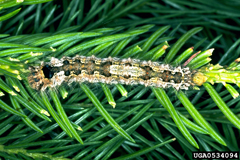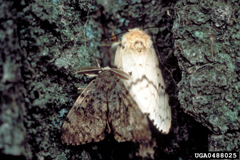Common Name
Nun Moth
Latin Name
Lymantria monacha
Order
Lepidoptera
Family
Lymantriidae
Main Host(s): Balsam Fir (Abies balsamea), White Spruce, Black Spruce, Red Spruce (Picea spp.)
Life Cycle
The Nun Moth has a one-year life cycle but unlike many other lepidopteran forest pests, it overwinters as an embryonic larva inside the egg. The eggs hatch in the spring (late April – early May) and the larvae begin to feed. Young larvae feed on new coniferous or deciduous foliage but as they mature the larvae will consume both young and older foliage. The larvae have six instars and pupate in July; the moths emerge several weeks later (males earlier than females) and the males will swarm in large flights, looking for females. Although the females can fly, they are more sedentary and they stay close to their point of emergence waiting to mate.
The females produce between 70 – 300 eggs in one or more clusters, each cluster containing about 40 eggs. The translucent grey brown eggs are hidden in bark crevices or under bark scales and the embryos complete their development in the eggs before entering into diapause for the winter.The Nun Moth is closely related to the Spongy Moth as they come from the same genus and family and their biology and impact are somewhat similar.


Impact & Damage
In many European countries, the Nun Moth is considered the most significant forest pest and can cause significant economic impact. While the Nun Moth is a major pest of both deciduous and coniferous trees, its damage seems to be more significant on coniferous species, especially in plantations. Host tree preference does vary between different geographic areas and climatic zones
The larvae are wasteful feeders and consume the base of needles, discarding the rest. On deciduous species, feeding damage is characterized by shotgun-like holes in the foliage until most of the leaf is consumed.
The Nun Moth is listed as an invasive species of concern in North America. As its lifecycle is similar to that of the Spongy Moth, it is anticipated that if established, damage caused by the Nun Moth to the forest ecosystems of North America would be comparable. Introduction and establishment of the Nun Moth would result in the mortality of individual trees and forest stands; coniferous species may be more susceptible.
Resources
Learn more about Nun Moth
Quick Links
Contact a Valent BioSciences public health representative.
Contact Us